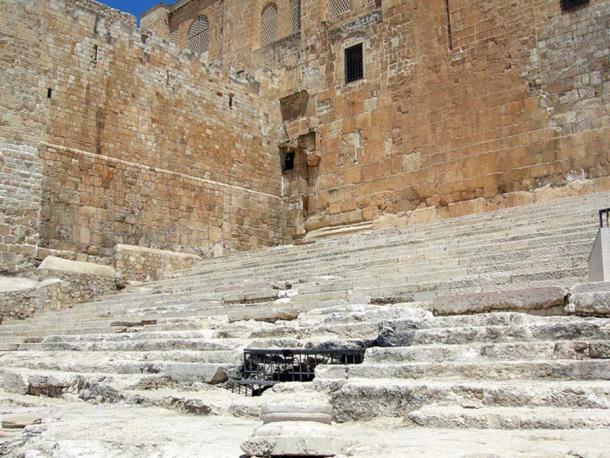Evidence Indicates Pilgrim’s Path Was Built By Pontius Pilate
The Israel Antiquities Authority has announced it has found solid evidence the Pilgrim’s Path in Jerusalem dates from the 1st century AD. This means that it was possibly commissioned by Pontius Pilate, the man who ordered the crucifixion of Jesus Christ. The discovery is expected to help researchers to better understand Jerusalem during a critical period in both Christian and Jewish history.
Archaeologists from the Israel Antiquities Authority and Tel Aviv University have been excavating the road under a Palestinian neighborhood, in the Old City of Jerusalem, for 6 years. The street was first discovered by British archaeologists in 1894, reports the Courthouse News Service. Excavations have since revealed that the route is 660 feet long (201.17 meters).
Ancient Pilgrim’s Path Uncovered
National Geographic reports that, ‘The impressive walkway stretched more than a third of a mile, was 26 feet wide (7.92 meters), and required some ten thousand tons of limestone slabs’. The street was built one block at a time and required a huge and highly skilled workforce. It was definitely not a typical Jerusalem street from the period.
It is believed that the street was of religious significance as it was connected to some of the holiest sites in Judaism, such as the Jewish Temple. The street ran from the Pool of Siloam to the Temple Mount. These sites are also revered in Christianity and they are mentioned in the New Testament. They are places associated with Jesus Christ prior to his crucifixion.

Pool of Siloam, the start of the Pilgrim’s Path, Jerusalem. (Robert Hoetink / Adobe Stock)
The street on what is now the Pilgrim’s Path would have been very grand for the time. Dr. Joel Uziel, of the Israel Antiquities Authority, stated its “finely carved stone and ornate furnishings, like a stepped podium along the street, all indicate that this was a special street,” according to the Independent. It is possible that the street was used by Jewish pilgrims in the 1st century AD, as they made their way to the Temple Mount during religious festivals.
Siege of 70 AD
The remains of the road were found beneath layers of rubble, which are believed to be from the Roman Siege of Jerusalem in 70 AD. The Independent reports that the rubble that covered the street for centuries contained ‘weapons, including arrowheads and sling stones’. In 70 AD, the legions under the future Emperor Titus (79-81 AD) utterly sacked the city after they captured it from Jewish rebels.
Around 100 Roman coins were found in the street. Researchers have established that the majority of the coins date to around 31 AD, however, the most common coins found in 1st century AD Jerusalem, are from after 40 AD. This helped the experts to date the street very precisely.
Dr. Donald Ariel, an expert on Roman coins, stated that “the street had to be built in the same year or after that coin had been minted, so any time after 30 CE,” reports the Courthouse News Service. Based on this, it is likely that the street was built during the governorship of Pontius Pilate (36/37 AD), the man who had Jesus Christ crucified.
- Telling Seal Unearthed in Jerusalem Names Biblical Figure
- Discoveries Show that Galilee and Jerusalem are Far Older than Once Believed
- Is this Seal More Evidence for the Biblical Account of Jerusalem?

Steps on the Pilgrim’s Path as they approach the Huldah Gates of the Temple. (Public Domain)
Pontius Pilate- New Insights?
This was a dramatic finding as it overturned existing ideas about the development of Jerusalem. It had been held that Herod the Great had funded the majority of building projects in the city around this time. However, now it seems that building continued under successive Roman governors. The finds could also challenge long-established ideas about the administration of Pontius Pilate.
In the New Testament and in other sources, the Roman governor is shown as antagonizing the Jews. For example, he allegedly promoted the worship of images, which was contrary to Jewish religious law. However, if as believed Pilate built the road, it shows him in a new light. National Geographic reports that Nahshon Szanton, who was involved in the excavation, speculates that Pilate had the street built “to appease the residents of Jerusalem.” There is some documentary evidence to support this hypothesis.
The discovery of the street is helping experts to better understand the development of Jerusalem during a crucial period in the history of Judaism and Christianity. If Pilate built the street, this may indicate that the Roman governor was more sensitive to the Jewish population than reported in the New Testament and other contemporary works. The results of the excavation of the street have been published in the Institute of Archaeology of Tel Aviv University Journal.
Top image: A section of the Pilgrim’s Path dating to the Second Temple period. Source: SHAI HALEVY/Israel Antiquities Authority
By Ed Whelan



















